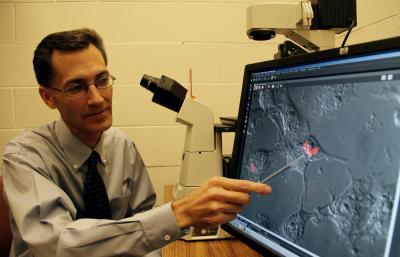There are an estimated 100,000 Histoplasma infections each year in the United States. Most are contained by the body's immune system, but each year a few thousand people will develop chronic or life-threatening histoplasmosis disease requiring hospitalization and antifungal treatment. The antifungals currently used to treat the infection have undesirable toxic side effects requiring monitoring by a physician and may need to be taken for weeks or months.
"Histoplasma is particularly good at avoiding detection by the body's immune system and surviving the immune response," said Jessica Edwards, PhD, a postdoctoral researcher at Ohio State University.
Respiratory histoplasmosis manifests with flu-like symptoms, often making diagnosis difficult. Rappleye says people with histoplasmosis have been mistakenly diagnosed with colds, the flu, and even lung cancer. "It depends on how familiar a physician is with histoplasmosis," he said.
Intrigued by the challenges of finding a new drug that would target the fungus without harming the human host, in 2012, Rappleye received pilot funding from Ohio State's Center for Clinical and Translational Science (CCTS) and the Public Health Preparedness for Infectious Diseases Program (PHPID).
Rappleye's team searched a library of commercially-available small molecules used by other investigators to find new antivirals or anticancer drugs. They performed a high-throughput phenotypic screen of 3,600 compounds looking for agents that inhibited fungal, but not human, cells.
To speed the selection process, Rappleye and Edwards engineered Histoplasma cells with a fluorescent protein that made the cells glow red while inside of a living macrophage – the type of mammalian immune cell that Histoplasma attacks and in which it reproduces.

Spotting fungal infections can be hard and treating serious cases can be difficult. Thanks to the work of Chad Rappleye, Ph.D., of the Ohio State University Wexner Medical Center, that could someday change. Rappleye has discovered a way to mark fungal infections so they turn bright red when active. His discovery could lead to a badly needed new class of drugs to fight fungal infections.
(Photo Credit: The Ohio State University Wexner Medical Center)
As the number of fungal cells increased inside the macrophage, so did the fluorescence and consequently, the cells would glow brighter. However, when a macrophage was exposed to an active compound that prevents Histoplasma reproduction, it maintained the same level of brightness. This allowed the scientists to quickly determine efficacy and toxicity of the drug candidate in a natural environment.
"Not only were we able to visually screen thousands of compounds in just a few weeks, but we were also able to measure the compound's impact in a real, live host cell," said Edwards.
The team narrowed down to a primary candidate called 41F5, which is 60 times more toxic to fungal cells than human cells. Their work was recently published in the September Antimicrobial Agents and Chemotherapy.
The team is currently working with Werner Tjarks, PhD, a medicinal chemist at Ohio State, to see if the selectivity and toxicity profile can be enhanced further for additional testing. Rappleye is also working with the Ohio State's Technology Commercialization Office (TCO) to potentially commercialize the derivatives from 41F5.
"There are people here in the U.S. and around the world suffering from varying degrees of histoplasmosis that need a safer and better treatment option. Our pilot study outcomes and methods are very encouraging, and I'm hopeful that with additional funding from the National Institutes of Health, we'll be able to keep moving at this accelerated pace," Rappleye said.
Histoplasma capsulatum spores are found across a broad stretch of the Midwest and southern United States. Experts estimate that 80 percent of people who live in the region have been exposed, and that nearly 10 to 25 percent of all AIDS patients living in these areas will develop a histoplasmosis infection. Once inhaled, the fungal cells can cause symptoms similar to an upper respiratory infection, and disease severity is dependent on how many spores are inhaled. In rare cases, histoplasmosis can cause blindness, joint pain, or life-threatening complications including meningitis and heart problems.

Disturbing the soil in the midwest and southern US often releases spores into the air of a fungus known as Histoplasmosis capsulatum. Most of the time the fungus is harmless, but an estimated 100,000 people a year develop lung infections because of it, and treating those patients can take months and cost $50,000 each. Researchers at the Ohio State University Wexner Medical Center have discovered a new way to find those infections, which could lead to a class of drugs that is safer and cheaper to use.
(Photo Credit: The Ohio State University Wexner Medical Center)

Chad Rappleye, Ph.D., tracks an active lung infection at The Ohio State University Wexner Medical Center. Rappleye discovered a process in which active fungal infections turn bright red under fluorescent light, making them easier to find. His work could lead to a new class of drugs to treat fungal infections in humans.
(Photo Credit: The Ohio State University Wexner Medical Center)